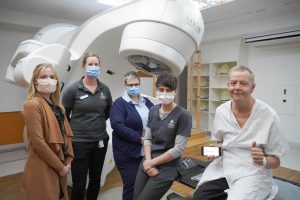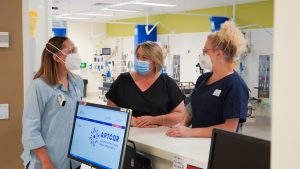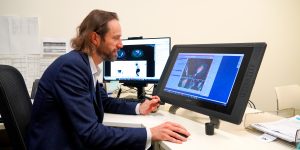Medical consultations by phone or video call (telemedicine), offered by the Royal Adelaide Hospital’s Radiation Oncology Department are as satisfactory as in-person consultations and more convenient, according to patients.
The results of a recent study by Radiation Oncologist Dr Vincent Pow and colleagues is the first in Australia to compare telemedicine and in-person radiation therapy consultations.
Just as good and more convenient
Telemedicine offers a practical solution for radiation therapy consultations to access patients in rural or remote areas.
The COVID-19 pandemic has accelerated the update of telemedicine practices in radiation oncology departments. Lead author of the study, Dr Vincent Pow, is pleased to see in the data that patients do not experience any dip in the satisfaction they feel towards the care they receive.
“Thankfully this study has shown that satisfaction is very high across the main domains and telemedicine can be used as an alternative to in-person appointments,” he said.
The study showed patients have a high level of satisfaction regarding telehealth in the important areas of communication, medical care, privacy/confidentiality, and convenience.
“When we’re talking about cancer, patients are at their most vulnerable and important information needs to be conveyed,” said Dr Pow.
“So it’s very reassuring that not only was rapport maintained, but people felt comfortable giving consent to treatment and receiving information this way.”
Reducing a barrier to healthcare
More than a quarter of Australians live outside major cities and are classified as ‘rural and remote’.
The logistical challenge they face is clear when considering that half of all cancer patients are likely to require radiotherapy at some stage, but most radiation therapy centres are located in metropolitan areas or larger regional centres.
The inaccessibility of radiation therapy to rural or remote Australians can mean patients have to incur travel costs and disruption to daily activities which ultimately impacts on quality of life.
Further still, there is evidence to show that for each 100 km increment in distance from the nearest Australian radiotherapy centre, there is a six per cent increase in mortality risk.
On average, patients in the study travelled an additional 233.5 kms and spent an additional $200 on costs or loss of income to access their in-person consultations compared to telemedicine consultations.
“The rural and remote patients are typically of lower socio-economic status, based on census data, and every dollar certainly counts for them,” said Dr Pow.
“Anytime away from their home town is tricky.”
Having to make alternative arrangements for children, pets and work add to the stress and burden already associated with having cancer.
Telemedicine alleviates the travel and accommodation costs which quickly add up, especially when patients want or need company at their appointments.
“It allows patients to have someone with them and to help digest the important information,” said Dr Pow.
Dr Pow and has plans to conduct a similar study for clinicians to analyse their experiences of telemedine.
For now though, it’s clear that telemedicine plays an important role in improving access to treatment for rural and remote Australians.
“Even if is just one appointment, or a few appointments, it really helps – and that’s certainly shown in the data,” said Dr Pow.



